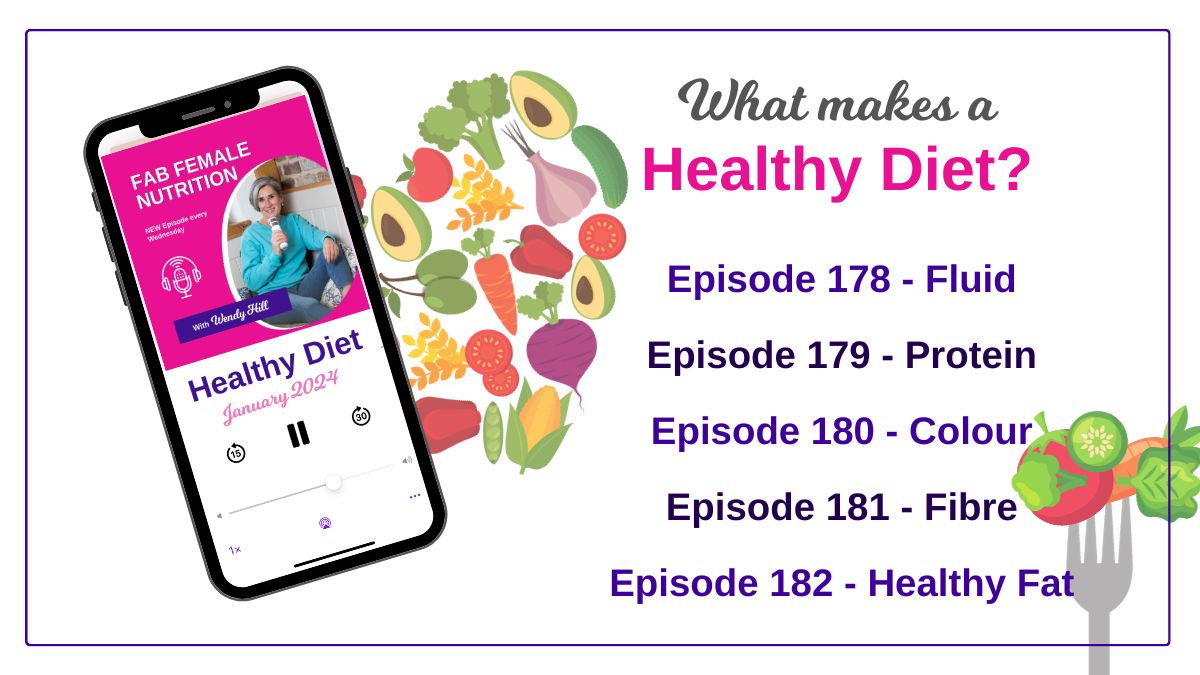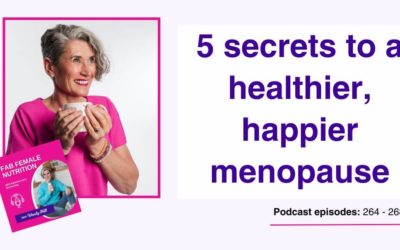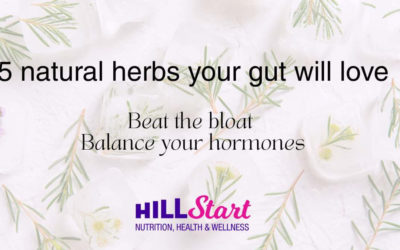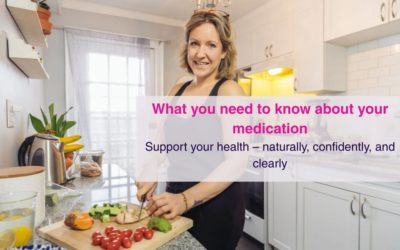What makes a healthy diet? I believe it’s just 5 simple ingredients. If eat these every day then you will feed your body with all it needs to boost your health, your energy and your wellbeing.
The 5 ingredients are :
Read on to see why they are so important and listen to a bitesize Podcast episode for each one.
1. A healthy diet starts with hydration
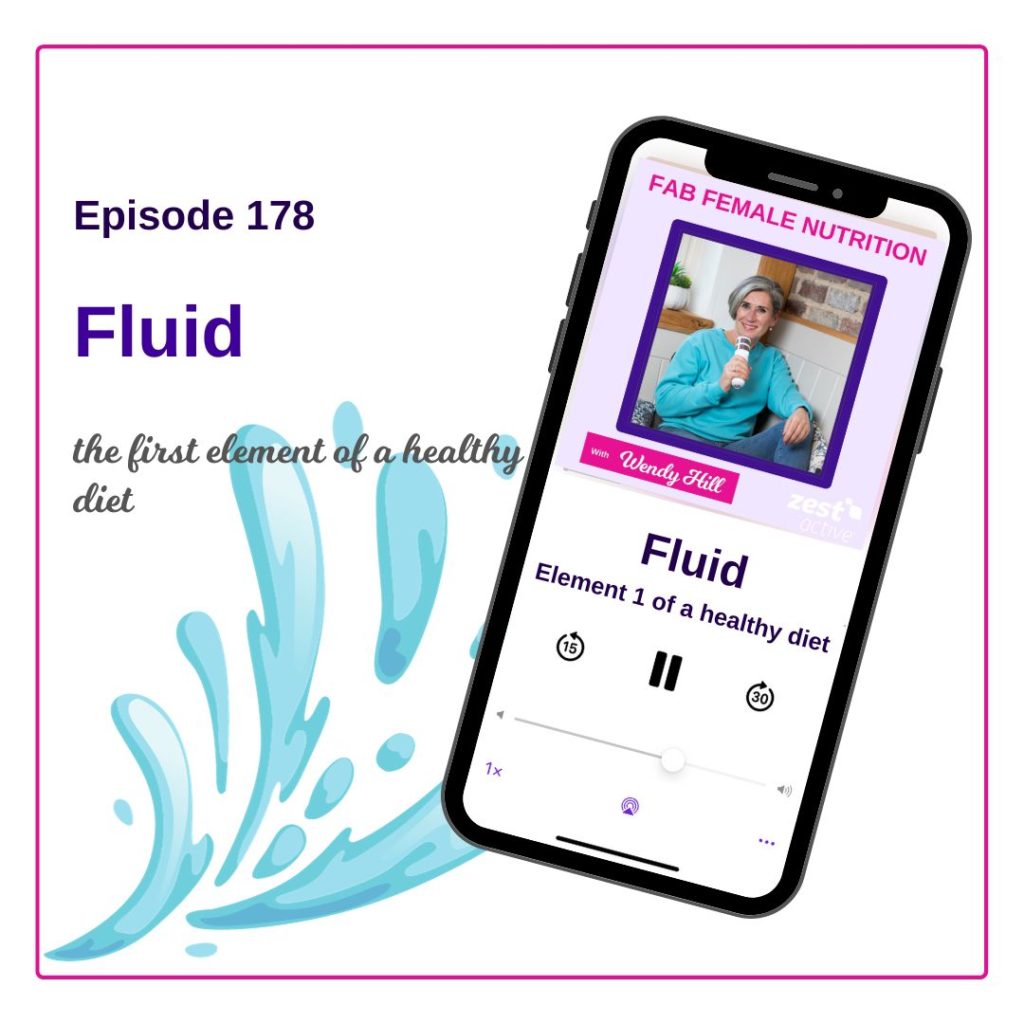
Our bodies are mostly water. Our total body composition is around 70% water, but more importantly that our brains are nearly 90% water. So staying hydrated is vital or our brains will simply start to shrink. Drinking fluid regularly throughout the day and eating foods containing fluid should keep us adequately hydrated, but it is surprising how many of us are not getting enough.
The government encourages us to drink 2 Litres of water per day (or 7 cups), but we are all different sizes and have different diets, so this is just a guideline. It’s important to note that it’s water, not fluid, so things like caffeinated or sugary drinks don’t count towards this, but herbal teas and naturally flavoured water do.
If you are eating lots of fresh vegetables and fruits, along with dishes that have both then you will be getting lots from your diet already. Things like watermelon (the clue is in the name), cucumber, tomatoes and celery are naturally high in water, so adding some to every meal can help keep you hydrated. And conversely if you are eating a diet that is very high in fibre then you might need to take on extra liquids. Water is also essential for supporting fibre in eliminating toxins from the body and creating healthy, well formed stools.
You see we are all so very different that it’s impossible to say definitively how much you need, however, there are a few things that you can look out for that will help you know whether you are getting enough or not for a healthy diet.
What are the signs of dehydration?
The easiest way to tell if you are hydrated or not is to check the colour of your pee. The average person goes for a wee about 6-7 times a day, and the colour should be a pale golden colour. It should not be dark, if it is, then down a big glass of water please. And if it is cloudy or smells then you should be speaking to your doctor.
There are also some physical and mental signs of dehydration, and often when you start to become better hydrated you will find that many of these symptoms that might have been plaguing you for a while simply disappear:
- headaches
- brain fog or poor concentration
- hunger
- fatigue, tiredness
- muscle cramps
- dizziness or confusion
- constipation
- thirst
Yes thirst is one of the last signs that you are not drinking enough. Also interesting is that hunger can be a sign of thirst. So next time you are feeling a bit of a mid-afternoon slump rather than reach for the biscuits think ‘thirst first’ and grab a glass of water first.
To listen to this podcast episode released on 3rd January click the link below
2. Why we need protein at every meal for a healthy diet.

Every single cell in our body needs protein; muscles, skin, and bones all need protein. It is our essential building block, and everything starts with protein, so it is important that we get a good helping with every meal. It also helps coordinate our signalling pathways – it’s key in sending messages around the body. And last, but no means least, it helps with hunger and satiety. There is a common hypothesis known as the protein leverage hypothesis that because protein is so essential to our health and development we will continue to eat until our protein needs have been met.
How much protein do we need every day?
The general agreement is that we need approx 0.8g to 1g of protein per Kg of weight daily. This amount does vary between nutritionist and it also depends on how old you are and how much exercise you do. Along with how much protein you actually get from the food that you eat. For example as we age we are less able to efficiently extract nutrients from food, so we might need more, and we don’t absorb protein from plant sources as well as we do from animal sources.
It is, as with all things nutrition, dependent on the individual, but if you work on 1g per Kg daily as a guide then you won’t go too far wrong. And if you have no idea how much protein you are actually eating then you can log your food using an app, the one I recommend to clients is chronometer, it’s free and easy to use, use it for a few days so that you can see what your average daily intake is. We don’t need to be too obsessive about it, as long as you are averaging the right amount if you eat a little more some days and a little less others that it isn’t a problem.
There has been a lot of talk about protein intake in recent months and a huge rise in foods that are labelled ‘high in protein’ or ‘added protein’. I would always encourage you to get your nutrients from your food and many of the products labelled high protein are actually ultra processed foods and will often contain ingredients that are not good for your health. I am also not a huge fan of protein powders, but if you really can’t get enough in your diet then you may need to supplement. Look for ones that doesn’t contain sugar or artificial sweeteners. Rice protein is the lowest allergen protein so if you have a delicate system that would be a good starting place. But find one that you enjoy the taste of I recommend using a trusted website such as Natural Dispensary and you can get 10% off if you use my discount code WHILL10
To listen to this podcast episode released on 10th January click the link below
3. Eat lots of colourful fruits and vegetables for a healthy diet.

Forget 5 a day, that is for amateurs, you should be aiming for at least eight portions of vegetables/salad and two to three portions of fruit every day. Eating as many different colours at each meal is key to getting all the phytonutrients your body needs.
We talk a lot about calories, macronutrients and even vitamins and minerals, but often forgotten are the phytonutrients that we only get from plant sources. There are over 100,000 of these amazing plant compounds and we are still learning about the benefits of them to our health and wellbeing. But one thing we do know is that each different colour, and even each different plant, has a unique combination of these phytochemicals that work synergistically to support our overall health.
Health benefits of red coloured vegetable and fruits
Items such as apples, peppers, cherries, strawberries and tomatoes are high in several different compounds including:
- Lycopene which has been shown to be protective against some cancers, particularly prostate cancer. It’s imortant to note that lycopene is more easily absorbed when cooked and tomatoes are a great source.
- Quercetin is one of the most abundant flavonoids. It has been shown to support inflammation and reduce allergic reactions, as well as improved exercise.
- Ellagic acid posseses antioxidant and antimutagenic properties and is found in berries.
Health benefits of purple/blue coloured vegetables and fruits
This is the smallest range and so the most difficult to get in your diet, but it is still possible to consume them daily. They include blueberries, blackcurrants, beetroot, figs and grapes. They are particularly antiinflammatory and high in several health promoting compounds:
- Resveratrol is not just an antioxidant it has immunomodulatory properties and can support glucose and lipid (fat) regulation. It has also been shown to be protective of the brain.
- Anthocyanins possess anti-obesity and antimicrobial properties. As well as supporting cardiovascular health and reducing blood pressure. They are masters at supporting long term overall health.
- Phenolics are absorbed through the intestinal wall and have been shown to reduce the damage to cells from free-radical oxidisation. Thus reducing inflammation and improving overall health.
Health benefits of orange/yellow coloured vegetables and fruits
There is a vast range to choose from in this variety including carrots, peppers, sweet potatoes, squash, peaches, the list is endless and it shouldn’t be difficult to get several different varieties every day. Often on the sweeter end of the taste pallet these are great vegetable to introduce to fussy children (or adults). Specific health benefits of the compounds include:
- Beta-carotene our bodies convert this into vitamin A, which is great for eye health. So yes your granny was right when she said that carrots help you see in the dark
- Zeaxanthin is another nutrient that is supportive of eye health, it is believed to act as a light filter so protects the eyes from damage from the sun.
- Hesperidin is a flavonoid that is found in many citrus fruits and is known to be antioxidant and anti-inflammatory. It has also been shown to support reduction in heart disease and neurodegenerative diseases.
Health benefits of white fruits and vegetables
Whilst beige is not a colour that I encourage you to eat too much of, there are lots of benefits of white vegetables and fruits which include cabbage, garlic, onions and mushrooms. Some argue that mushrooms should be in a class all of their own, but regardless they can be included in a healthy balanced diet and some of the specific benefits of white fruits and vegetables include:
- Allicin may be supportive of reducing blood pressure and is found in high levels in garlic and onions. It is also believed to support a reduction in cholesterol levels.
- Beta Glucans are found in mushrooms and can support our immune system regulation.
- Indoles are known to support detoxification enzymes in both our digestive system and our liver.
Health benefits of green fruits and vegetables
I joke that ‘green leafy vegetables’ is the answer to every nutrition question, but that is only said half in jest as there are some very good reasons why adding green vegetables and fruits to your diet is supportive of your health and wellbeing. These include grapes, spinach, rocket, cucumber and many, many more:
- Sulforaphanene nutralises toxins in the body and therefore reduces inflammation. it has antioxidant, antimicrobial and antioxidant properties. It is found in many cruciferous vegetables which are support detoxification and liver health.
- Isoflavones have been shown to reduce the number of hot flushes during perimenopause, this is due to their oestrogen balancing properties.
- Isothiocyanates are found in cruciferous vegetables and are believed to be protective from some forms of cancer including gastric cancers.
Key to a getting the most benefit is to eat a wide variety of vegetables, salad and fruits. Aiming to tick off each colour of the rainbow daily, and getting a different variety each day. Try to eat organically where possible and always seasonally, next time you go shopping look to see what is seasonal and if there is something you haven’t tried before add it to your basket.
To listen to this podcast episode released on 17th January click the link below
4. Why is fibre so important to our health?
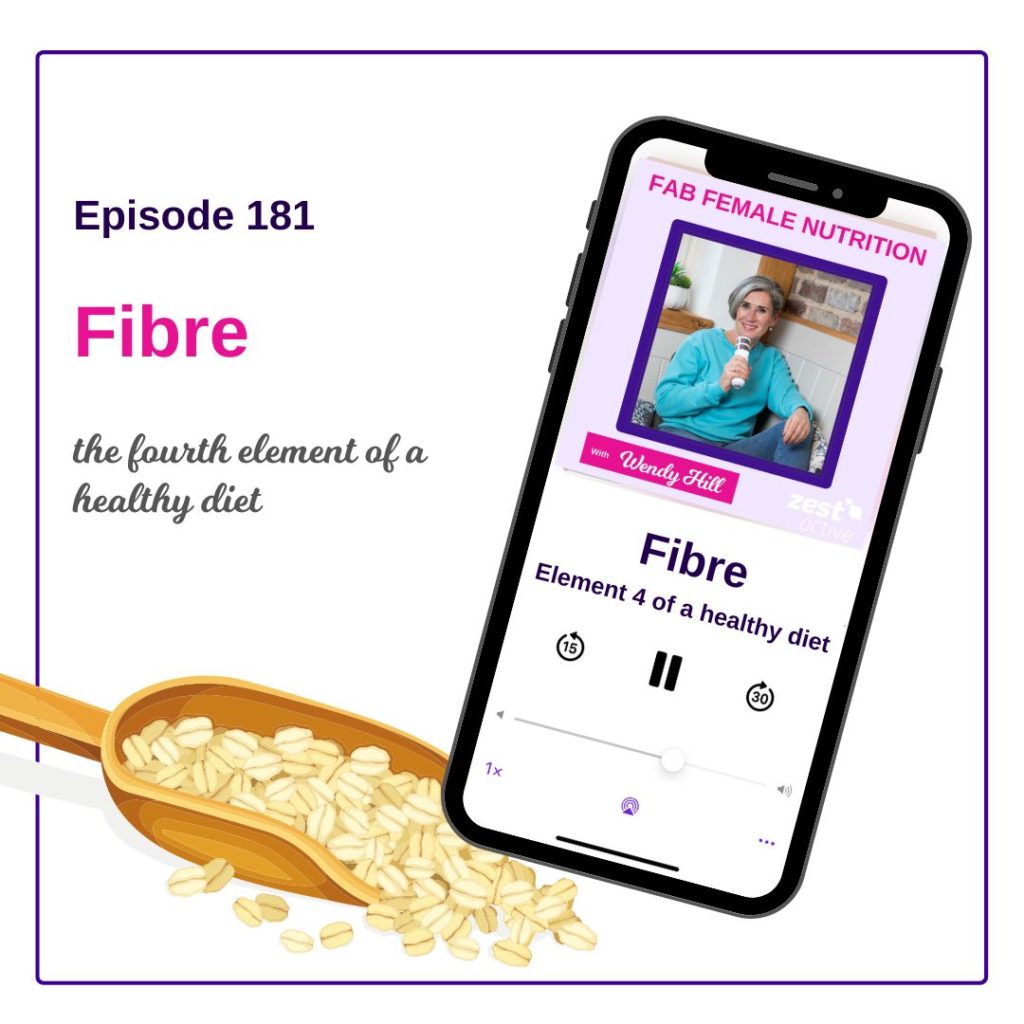
I think that fibre is a forgotten nutrient. We talk about carbohydrates, often quite negatively, but what we should be talking about is fibre. Fibre is an essential nutrient that is vital to the health of our gut. And anyone who is interested in their health knows that a healthy gut is vital.
We should think about fibre like a protective barrier for our digestive system. Foods, drinks and medication that we ingest are inflammatory to our digestive lining, and if this inflammation becomes chronic it can lead to digestive conditions such as IBS, leaky gut, bloating and discomfort. When we eat foods high in fibre the fibre acts as a little protective barrier for our digestive lining and therefore protects it from damage. Fibre is also the food of our good gut microbes, so eating fibre rich foods supports our microbial balance.
Fibre is also key in stool formation, along with hydration (element 1 of our healthy diet). Having well-formed stools and regular bowel movements helps remove toxins and waste products from the body. I find that clients who have had difficulties get quick relief from simply upping their fibre and water intake.
How much fibre should I be eating?
The government guidelines state that women should be getting a minimum of 25g a day, and men 30g a day. Just to give you an idea of how much I eat, my most recent 3 Day Gut Reset plan contained between 39g and 44g per day, and it’s not unusual to see a plan with over 50g on some days. However, it is important to note that you shouldn’t increase your intake too quickly, take a few days to add more of the ingredients listed below, and always make sure you drink plenty of fluid.
Good sources of fibre:
- Cruciferous vegetables
- Apples & Pears
- Wholegrains
- Nuts & Seeds
- Legumes (beans, chickpeas, lentils)
- Oats
- Avocados
To listen to this podcast episode released on 24th January click the link below
5. Including the right kind of fat in your diet is vital
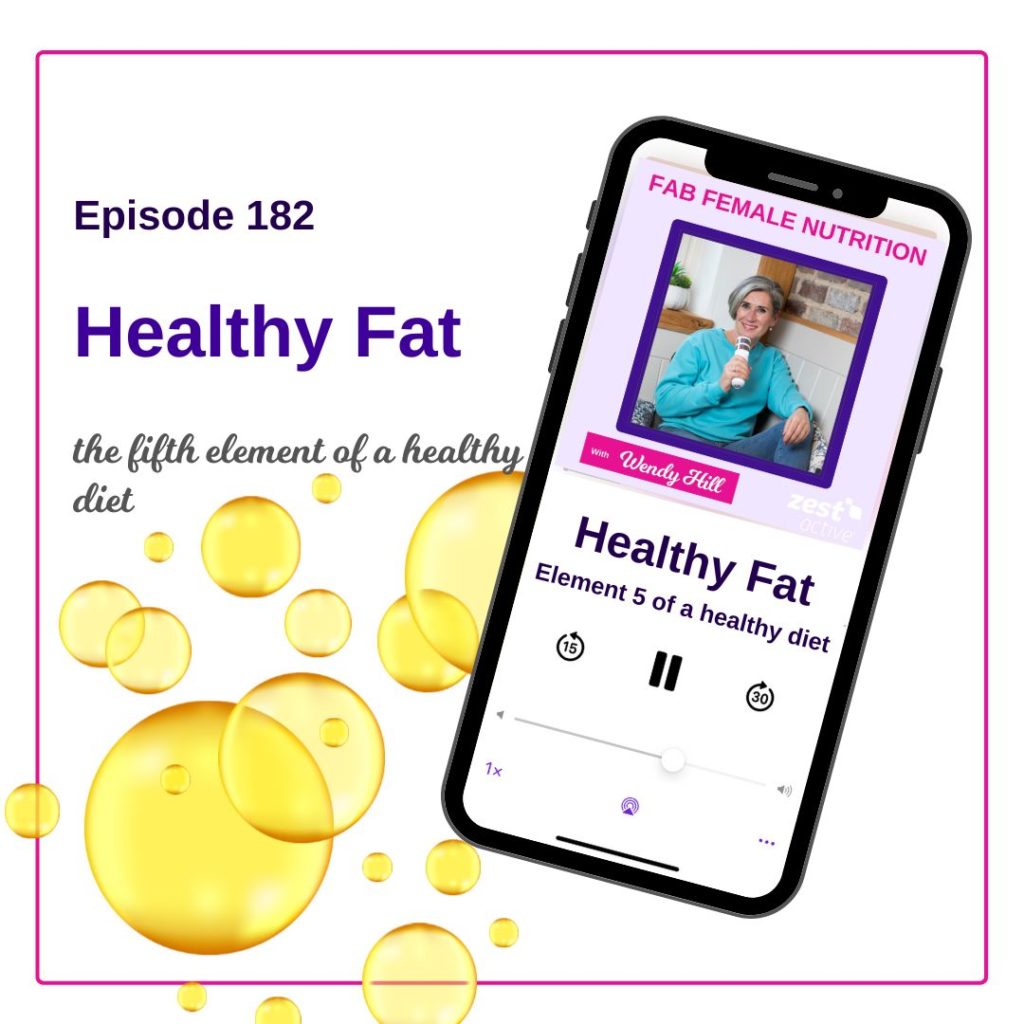
Healthy fats are the fifth element to our healthy diet, we make many hormones including our sex hormones from fats, they are key in our brain health and help to reduce inflammation. So they deserve the final spot in our healthy diet. They are high in calories at 9 calories per gram (compared to 4 calories from protein and carbohydrates) so they should be consumed in moderation and focus on unsaturated fats which are the healthiest ones.
I released an episode of the podcast way back in episode 61, where I explain lots more about the good, the bad and the ugly of fats.
What is healthy fat?
The healthiest fat is unsaturated fats which can be found in things like olive oil. Nuts and seeds are also a great source of unsaturated fat and these are also high in fibre (foods don’t just live in one part of the elements). Also key to include is oily fish such as salmon and mackerel. Healthy fats are also associated with satiety, they can help keep you feeling fuller for longer, so including some at every meal with stop that snacking and can ultimately reduce your overall calorie intake if that is something you are working on.
Good fats are a rich source of omega 3, which is an essential fatty acid. We need to consume this as our body does not make this type of omega and so we need to ensure we get enough from our foods. Omega 3 is key in supporting healthy joints and skin, but also our hormones which affect a multitude of things including our mood our sleep and even how messages travel around our body.
What fats should I avoid?
Next on our list in order of health promoting benefits is saturated fats. These are mostly found in animal products and whilst they are not harmful to our health they don’t contain as much omega 3 as unsaturated fats. They do form part of a healthy balanced diet, but should be consumed in moderation. They are generally higher in omega 6, which we do need to eat but high levels can cause inflammation which is why it’s good to monitor how much you consume.
Trans-fats should be avoided in our diets whenever possible. They are transformed fats and our bodies do not recognise these and therefore we don’t know now to process them correctly. They are highly inflammatory to the body and are most commonly found in fried or processed foods, which often also contain added chemical ingredients which are not supportive of our health.
To listen to this podcast episode released on 31st January click the link below
Did you enjoy this month’s episodes? Let me know
My links
A note about our sponsor
Revive Active, Ireland’s leading Super Supplement Brand, we are proud to have them as sponsors of this podcast as their formulas stand out as a powerhouse of premium ingredients, working together in perfect harmony to bring you optimum benefits.
Revive Active is committed to selecting components that not only enhance your vitality but also cater to your specific needs. Every ingredient is carefully chosen for its efficacy and is supported by rigorous scientific research. Revive Active believes in transparency. What you see on the label is what you get – no hidden ingredients or undisclosed fillers, binders, caffeine, or stimulants. Convenience meets effectiveness in every sachet, from radiant skin to boosted energy levels, each formula is designed to enhance your overall well-being.
My favourites from their range
REVIVE ACTIVE is a powerhouse of 26 active ingredients—your essential replenishment for what life takes out with the support of HERO ingredients like CoQ10 for cellular energy, Citrulline DL Malate to fight fatigue and support heart health, and L-Arginine for active blood flow.
Meet MASTERMIND, your brain’s secret weapon! This specially formulated supplement supports brain function with a potent mix of 7 vitamins, 1 mineral, Omega 3 DHA, Uridine, and Choline—all in one handy sachet. Enhance mental focus, and beat that mid afternoon slump without interfering with your sleep, this is your maximum productivity and focus tool. Plus, it’s Vegetarian, Gluten-Free, and Halal Certified.
BEAUTY COMPLEX, one of the award-winning super supplements, boasts 8 potent ingredients in one easy, convenient sachet. Featuring Type 1 Marine Collagen, Hyaluronic Acid, Phytoceramides and Biotin, the synergy of these HERO ingredients goes beyond aesthetics, aiming to reduce visible signs of aging and enhance your overall look and feel. Beauty, indeed, starts from within.
Embrace menopause fearlessly with MENO ACTIVE—a product backed by over two years of dedicated research. This unique blend of 31 active ingredients, including 12 vitamins, 7 minerals, 4 plant extracts, Omega 3 DHA and more, is designed to support you during this transformative journey of change. With a daily sachet and capsule, it’s a powerful combination to navigate the menopausal phase with ease. Meno Active is your empathetic companion for a smoother transition.
Join me and countless women who have made Revive Active an integral part of their daily routine, experiencing a positive impact on their health and overall well-being.
Want to know more about ways to work with me?
There are many ways that you can work with me to balance your hormones and improve your health and wellbeing.
On Facebook the Fab Female Nutrition Club is a wonderful FREE community where I offer lots of support and advice on female health and wellbeing. I also love to cook and create recipes and I’ll often be seen in the group cooking live and sharing all the wonderful health benefits of the ingredients used.
My Fab Female Nutrition Membership sits alongside the free club, but offers you lots of resources and group coaching with me. The hub has the full recipe book that is constantly being updated, the 5 elements of health containing resources and guides to help support you in your health journey. And 6 group coaching calls a year, plus access to other member benefits such as discounts from group programs.
A few times a year I work with groups of ladies to transform their health and wellbeing. Appropriately called The Transformation Program it can help with many differing issues and we have had hugely impressive results – including up to 100% reduction in symptoms. If you suffer with IBS, fatigue, inflammation, hormonal imbalances or just want to spend some time concentrating on your health and wellbeing they are fabulous value and great fun.
If you feel like you need a more bespoke option, then my 1:1 coaching and testing is for you. We will concentrate on your specific needs creating nutritional protocols that support your health goals. We take a full health history, then tailor testing to help create and refine protocols so that you learn about your body and how to support it. I will be with you every step of the way to guide you and ensure that you realise your true health potential. Find out more here.
